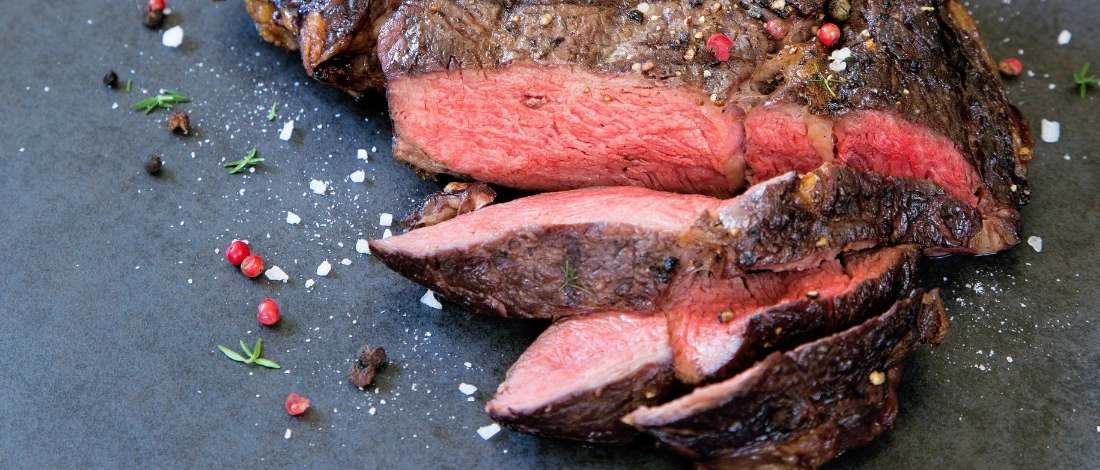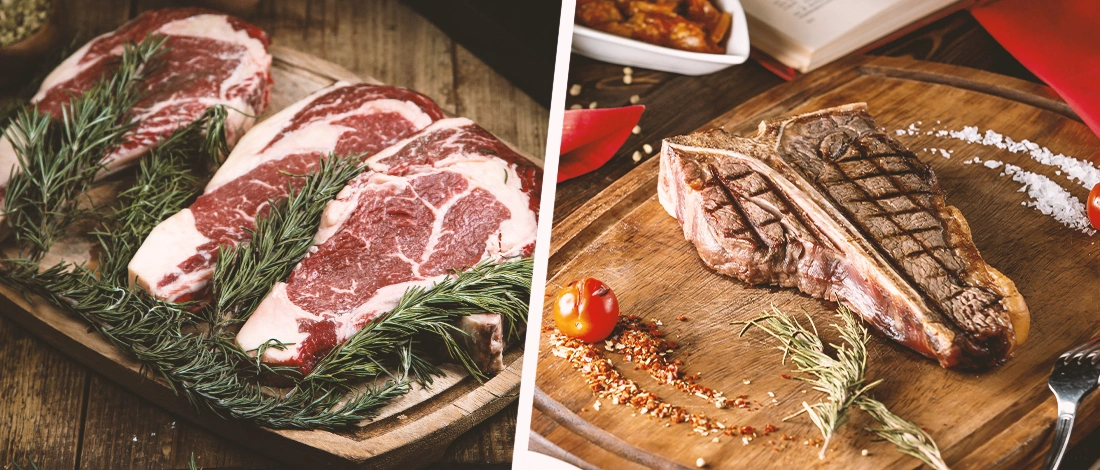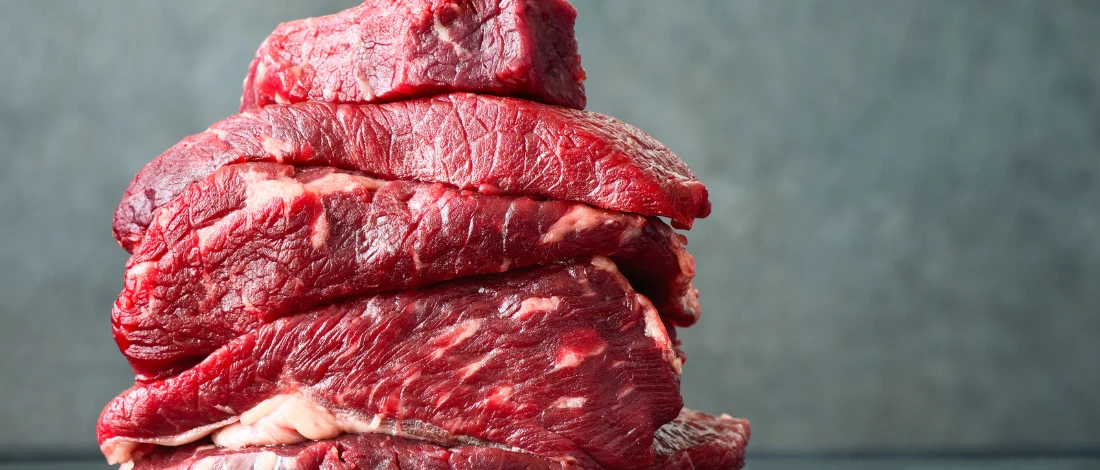Each carnivore I talked to loves a good steak, and two of the most popular types are the New York strip and the ribeye steaks. But what makes these cuts of meat different from each other, and which should you choose?
Well, I have researched the New York strip vs ribeye steaks topic thoroughly, both with my favorite butcher and also on my grill. Read on to see what I have learned.
Quick Summary
- The New York Strip and Ribeye are two popular steak cuts with distinct characteristics; the former is leaner and comes from the short loin area, while the latter is rich in marbling and comes from the rib section.
- The New York Strip is typically grilled, pan-fried, or broiled.
- The Ribeye, due to its high-fat content, can be grilled with caution or pan-seared for optimal flavor.
5 Characteristics of NY Strip

To start the comparison of these two steaks, let's look at New York strip steaks.
1. Location
The New York strip is a cut of beef that comes from the short loin area of the cow. The short loin is the area right in front of the rear leg, behind the ribs.
The steak is cut from the cow's longissimus dorsi, an underused muscle group. This makes New York strip quite tender.
Interestingly, the New York strip makes up half of a Porterhouse steak, and a thick band of fat usually lies along one side of the steak [1].
2. Shape and Size
The New York strip steak is long and thin, with a rectangular shape. It typically weighs between 8 and 12 ounces.
It is not a particularly fatty cut of beef, so the New York strip usually comes about 1 to 1 1/2 inches thick to keep it from drying out during cooking.
3. Names

The New York strip steak goes by quite a few different aliases. These include:
- Omaha strip
- Shell steak
- Veiny steak
- Top Loin steak
- NY Strip Loin steak
- Ambassador steak
- Boneless Club steak
- Hotel-Style/Cut steak
- Country Club steak
- Kansas City steak/strip
4. Taste and Texture
The NY strip steak is known for its rich, beefy flavor. This is due to the low amount of marbling in the meat, which gives it more flavor.
Despite the lower fat content, the New York strip has a smooth texture and is also quite tender, making it a popular choice for those who want a leaner steak.
5. Cooking
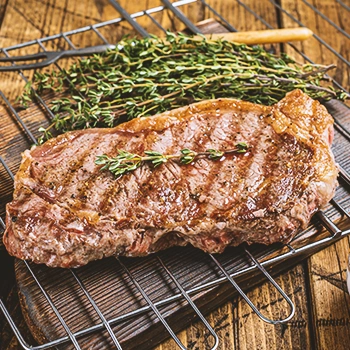
A New York strip steak can be cooked properly in several ways but is typically grilled, pan-fried, or broiled on a wire rack.
New York strip steaks are relatively simple to grill because they do not have a lot of fat. That means you are less likely to have flare-ups when grilling.
Just be sure not to overcook it, as this can make the steak tough. Grilling hot and fast is the best way to get a nice char on the outside while keeping the inside rare or medium rare.
If you pan-fry your steak, you will want to use a bit of olive oil in the pan to help cook it evenly.
5 Characteristics of Ribeye Steak

Now let's take a look at ribeye steaks.
1. Location
The ribeye is cut from the rib prime cut of the cow. The rib section is the area between the shoulder and loin, right in front of where the New York strip steak comes from. Usually, the meat is harvested from ribs 6-12.
Since the rib area does not have well-exercised muscles, the meat comes with a good amount of fat marbling.
Like the strip, the ribeye is taken from the longissimus dorsi muscle strips, which is why it is also a tender cut of beef. Some cuts will contain the spinalis dorsi and complexus muscles.
2. Shape and Size
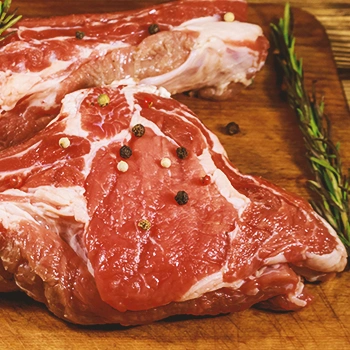
Ribeye beef steaks are not as narrow as New York strip steaks and have a more oval or round shape. They also may have a significant fatty area running through them where the longissimus and spinalis muscles come together.
These steaks are typically fairly thick; you want them to be at least an inch thick. They can also be quite large, with some weighing as much as 16 ounces.
Finally, you can get either bone-in or boneless ribeye. Many think that bone-in adds a rich flavor to the steak, but it does make cutting and eating more challenging.
3. Names
Ribeyes also goes by a few different names, including:
- Delmonico steak
- Market steak
- Spencer steak
- Beauty steak
- Cowboy cut
- Entrecote
- Scotch fillet
4. Taste and Texture
The ribeye is known for being a flavorful steak. The bone attached and fat content of the meat provide richness and fatty flavor that other steaks do not have.
The marbling also helps keep the steak moist, even if it is overcooked.
The ribeye is also a very tender steak, making it a popular choice for those who want a juicy steak.
This is due to a large amount of marbling in the meat. Internal marbling gives the beef an almost buttery texture
5. Cooking
If you're looking for a service to bring quality, grass-fed New York strip and ribeye steaks to your door, my honest recommendation goes to ButcherBox.
You can cook ribeye in many ways, but they are most often grilled, pan-fried, or broiled.
Grilling ribeye can be challenging because of its high-fat content. The fat running down can cause flare-ups with high heat, so you must be careful when grilling and have your tongs nearby. The fat level also makes this best-cooked medium-rare to medium-well.
"Cooking steak is a joy because it is a terrific piece of meat that has great flavour whether it is grilled or pan-fried."
- John Torode, Australian Chef
It also may help to use a two-zone grilling technique. Initially sear the outside over high heat and then shift to more indirect heat so that you can control the temperature and prevent the steak from flaring.
When cooking ribeye, I almost always opt for pan-searing, which is a good option if you do not want to deal with the potential problems of grilling.
The fat content of the ribeye may mean that you do not need to add oil to the pan. This is super important if you’re on a regimen or just want to keep your fat intake to a minimum.
Read More: How to Grill Ribeye Steak?
4 Key Differences Between NY Strip and Ribeye Steaks

Now that we have some information about New York strips and ribeye steak, let's look at some of the key differences between these two popular cuts of beef.
1. Marbling
The first difference is the amount of marbling. The New York strip has less marbling than the ribeye steak, which means it will be a leaner, healthier steak cut.
The ribeye, coming from the upper rib cage, is known for its rich flavor due to its higher saturated fat content.
2. Tenderness
Although both have a far more tender texture than cuts such as the flank or skirt steak, the ribeye is typically considered to be the more delicate of the two.
This is due to the steak's higher fat, making it more moist and juicy. The strip has the tighter texture of the two steak cuts.
3. Price
The third difference is price. Ribeye steak is typically a more expensive steak cut than the New York strip. That said, you are only looking at $1-2 per pound more for a ribeye premium steak when purchased at butcher shops or the grocery store [2].
Of course, the price differential in a restaurant may be significantly more.
4. Grilling
Both the ribeye and New York strip taste great when prepared over the charcoal or gas grill. It is one of the best cooking methods for these steaks.
However, the New York strip is easier to cook since it has less fat. The ribeye steak can be more challenging to grill because the fat can cause flares.
You can also cook either steak using the reverse sear method to get the internal temperature to 145 degrees Fahrenheit on a meat thermometer.
References:
- https://www.beefitswhatsfordinner.com/cuts/cut/2770/strip-steak-bone-in
- https://www.ams.usda.gov/mnreports/lswbfrtl.pdf




